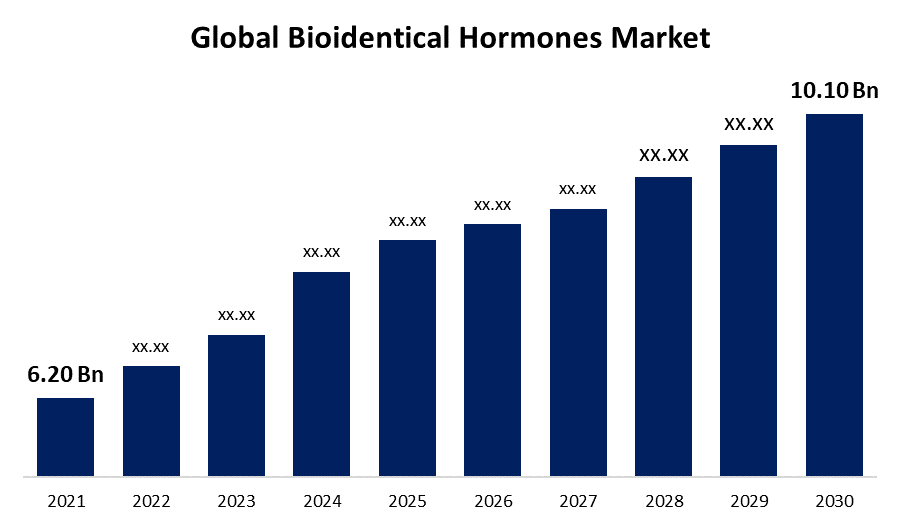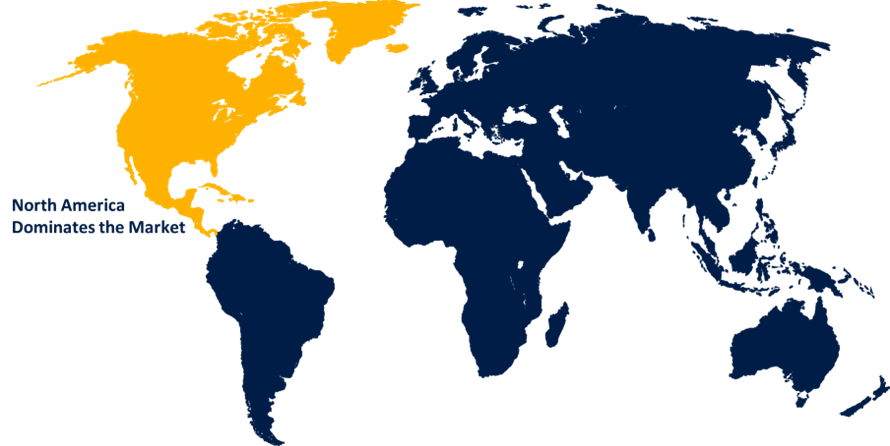Global Bioidentical Hormones Market Size, Share, and COVID-19 Impact Analysis, By Product (Tablets & Capsules, Creams & Gels, Injectables, Patches & Implants, Others), By Administration (Oral, Parenteral), By End User (Hospitals, Clinics, Others), By Region (North America, Europe, Asia-Pacific, Latin America, Middle East, and Africa), Analysis and Forecast 2021 - 2030
Industry: HealthcareGlobal Bioidentical Hormones Market Insights Forecasts to 2030
- The Bioidentical Hormones market was valued at USD 6.20 billion in 2021.
- The market is growing at a CAGR of 6.50% from 2022 to 2030
- The global Bioidentical Hormones market is expected to reach USD 10.10 billion by 2030
- Asia Pacific is expected to grow the fastest during the forecast period

Get more details on this report -
The global Bioidentical Hormones market is expected to reach USD 10.10 billion by 2030, at a CAGR of 6.50% during the forecast period 2022 to 2030.
Market Overview
Bioidentical hormones are defined as synthetic hormones that share the same molecular make-up and chemical composition as endogenous human hormones. From plant sources like soybeans and yams, bioidentical hormones are obtained and produced. While they are created in a laboratory to be biologically identical in structure and function to the hormones produced in the body, these are in some ways regarded as natural. Estrogen, progesterone, testosterone, and dehydroepiandrosterone are examples of bioidentical hormones (DHEA). The bioidentical hormones can be made in a variety of forms, including pills, patches, injectables, creams, and more. These hormones are utilised as a therapeutic option for those who have been identified as having low hormone levels or a hormone imbalance. Such bioidentical hormones are available to patients in two different forms: first, as an FDA (Food and Drug Administration)-approved preparation that is made under strict supervision and distributed by retail pharmacies; or second, from compounding pharmacies, where the hormones are transformed from their original form into a tailored form in accordance with the patient's needs.
Report Coverage
This research report categorizes the market for Bioidentical Hormones market based on various segments and regions and forecasts revenue growth and analyzes trends in each submarket. The report analyses the key growth drivers, opportunities, and challenges influencing the Bioidentical Hormones market. Recent market developments and competitive strategies such as expansion, product launch and development, partnership, merger, and acquisition have been included to draw the competitive landscape in the market. The report strategically identifies and profiles the key market players and analyses their core competencies in each sub-segments of the Bioidentical Hormones market.
Global Bioidentical Hormones Market Report Coverage
| Report Coverage | Details |
|---|---|
| Base Year: | 2021 |
| Market Size in 2021: | USD 6.20 Billion |
| Forecast Period: | 2021-2030 |
| Forecast Period CAGR 2021-2030 : | 6.50% |
| 2030 Value Projection: | USD 10.10 Billion |
| Historical Data for: | 2017-2020 |
| No. of Pages: | 195 |
| Tables, Charts & Figures: | 125 |
| Segments covered: | By Product, By Administration, By End User, By Region, And COVID-19 Impact Analysis |
| Companies covered:: | SottoPelle, Novartis AG, Orion Pharma AB, Full Life Wellness Center, BioTE Medical, LLC, Merck KGaA, Pfizer Inc., TherapeuticsMD, Inc., Papillon Medical, United Pharmacy, Noven Pharmaceuticals, Inc.GEA Group Aktiengesellschaft Novo Nordisk A/S, GeneScience Pharmaceuticals Co., Ltd., Actiza Pharmaceutical Private Limited, Defy Medical, Neuva Aesthetics, ZRT Laboratory, Bayer AG, Allergan |
| Growth Drivers: | Over the past two decades, a trend has emerged in which the majority of doctors have begun to show more interest in bioidentical hormones than their synthetic equivalents because the former poses fewer health risks than the latter. |
| Pitfalls & Challenges: | Due to the increasing number of COVID-19 cases |
Get more details on this report -
Driving Factors
Over the past two decades, a trend has emerged in which the majority of doctors have begun to show more interest in bioidentical hormones than their synthetic equivalents because the former poses fewer health risks than the latter. For the treatment of menopausal symptoms and to promote general health, they have begun to choose bioidentical hormones. According to research from the U.S. government-sponsored Women's Health Initiative (WHI), the hazards of non-bioidentical hormones (particularly Premarin and Provera) in hormone replacement therapy (HRT) surpassed the advantages they provided in 2002. As a result, rising female health consciousness is anticipated to fuel market expansion. Also, the market for bioidentical hormones is expanding since hormonal imbalance problems are becoming more common.
Restraining Factors
The population's growing health worries about issues like purity, contamination, dose, or accuracy of compound bioidentical hormones may have an impact on market growth.
Market Segmentation
- In 2021, the tablets and capsules segment is dominating the market over the forecast period.
On the basis of Product, the market is bifurcated into Tablets & Capsules, Creams & Gels, Injectables, Patches & Implants, Others. Among these, the tablets and capsules segment is dominating the market over the forecast period. Its proportion can be ascribed to elements like increasing bioidentical hormone capsule consumption and increased market availability of tablets and capsule products.
- In 2021, the Oral segment is generating the highest revenue over the forecast period.
On the basis of administration, the global bioidentical hormones market is segmented into oral and parenteral. Among these, the oral segment is generating the highest revenue over the forecast period. As comparison to intravenous (IV) therapy provided in a clinical setting, the rise of oral chemotherapy for the treatment of cancer gives many patients a more practical and minimally intrusive treatment choice. A new approach to patient education, monitoring, and support is necessary in light of the advancements in cancer therapy; this approach relies on integration and cooperation between doctors, pharmacists, and other healthcare professionals involved in the patient's care.
- In 2021, the Hospitals segment holds the highest market share over the forecast period.
Based on the end user, the global bioidentical hormones market is segmented into hospitals, clinics, others. Among these, the hospitals segment holds the highest market share over the forecast period. They offer patients more individualised counselling than clinics. But hospitals are also connected to research centres and medical institutions to provide patients with additional care and security.
Regional Segment Analysis of the Bioidentical Hormones Market

Get more details on this report -
- North America (U.S., Canada, Mexico)
- Europe (Germany, France, U.K., Italy, Spain, Rest of Europe)
- Asia-Pacific (China, Japan, India, Rest of APAC)
- South America (Brazil and the Rest of South America)
- The Middle East and Africa (UAE, South Africa, Rest of MEA)
North America is dominating the market with the largest market share.
Among all other regions, North America is dominating the market with the largest market share. During the course of the estimate period, calculations like improvements to the systems for delivering medications, the development of new information, and an increase in the number of target populations in North America are expected to maintain its strength. The NIH reports that a fraction of postmenopausal women have used HRT at least once.
Competitive Analysis:
The report offers the appropriate analysis of the key organizations/companies involved within the global Bioidentical Hormones market along with a comparative evaluation primarily based on their product offering, business overviews, geographic presence, enterprise strategies, segment market share, and SWOT analysis. The report also provides an elaborative analysis focusing on the current news and developments of the companies, which includes product development, innovations, joint ventures, partnerships, mergers & acquisitions, strategic alliances, and others. This allows for the evaluation of the overall competition within the market.
List of Key Companies
- SottoPelle, Novartis AG
- Orion Pharma AB
- Full Life Wellness Center
- BioTE Medical, LLC
- Merck KGaA
- Pfizer Inc.
- TherapeuticsMD, Inc.
- Papillon Medical
- United Pharmacy
- Noven Pharmaceuticals, Inc.
- GEA Group Aktiengesellschaft
- Novo Nordisk A/S
- GeneScience Pharmaceuticals Co., Ltd.
- Actiza Pharmaceutical Private Limited
- Defy Medical
- Neuva Aesthetics
- ZRT Laboratory
- Bayer AG
- Allergan
Key Target Audience
- Market Players
- Investors
- End-users
- Government Authorities
- Consulting And Research Firm
- Venture capitalists
- Value-Added Resellers (VARs)
Recent Developments
- In 2022, Pfizer Inc. completed acquiring Arena Pharmaceuticals. This acquisition will lead to an expansion of the portfolio into dermatology, cardiology, gastroenterology, and other fields.
- In 2020, AbbVie acquired Allergen Plc. This acquisition will likely expand the portfolio to include oncology, immunology, neuroscience, and other fields.
Market Segment
This study forecasts revenue at global, regional, and country levels from 2019 to 2030. Spherical Insights has segmented the global Bioidentical Hormones market based on the below-mentioned segments:
Bioidentical Hormones Market, By Product
- Tablets & Capsules
- Creams & Gels
- Injectables
- Patches & Implants
- Others
Bioidentical Hormones Market, By Administration
- Oral
- Parenteral
Bioidentical Hormones Market, By End Users
- Hospitals
- Clinics
- Others
Bioidentical Hormones Market, Regional Analysis
- North America
- US
- Canada
- Mexico
- Europe
- Germany
- Uk
- France
- Italy
- Spain
- Russia
- Rest of Europe
- Asia Pacific
- China
- Japan
- India
- South Korea
- Australia
- Rest of Asia Pacific
- South America
- Brazil
- Argentina
- Rest of South America
- Middle East & Africa
- UAE
- Saudi Arabia
- Qatar
- South Africa
- Rest of Middle East & Africa
Need help to buy this report?